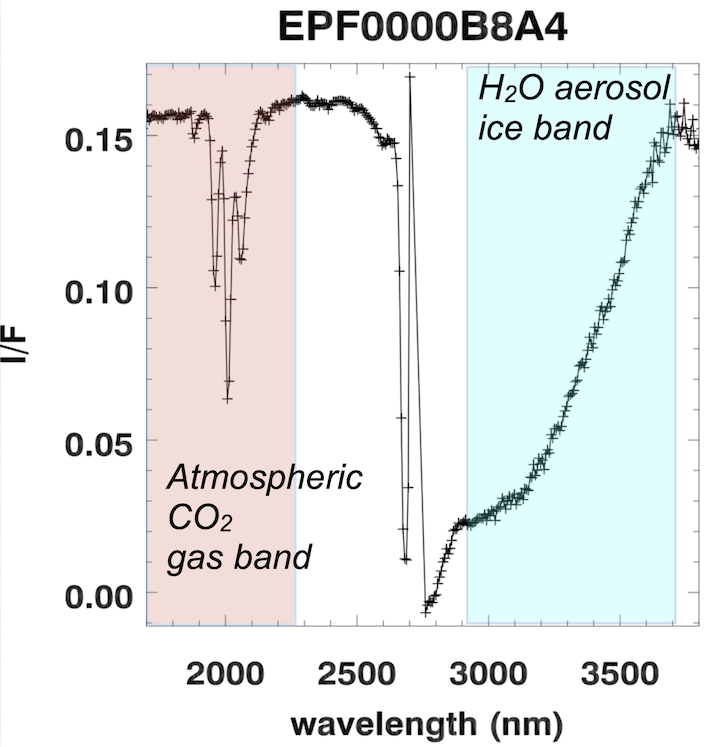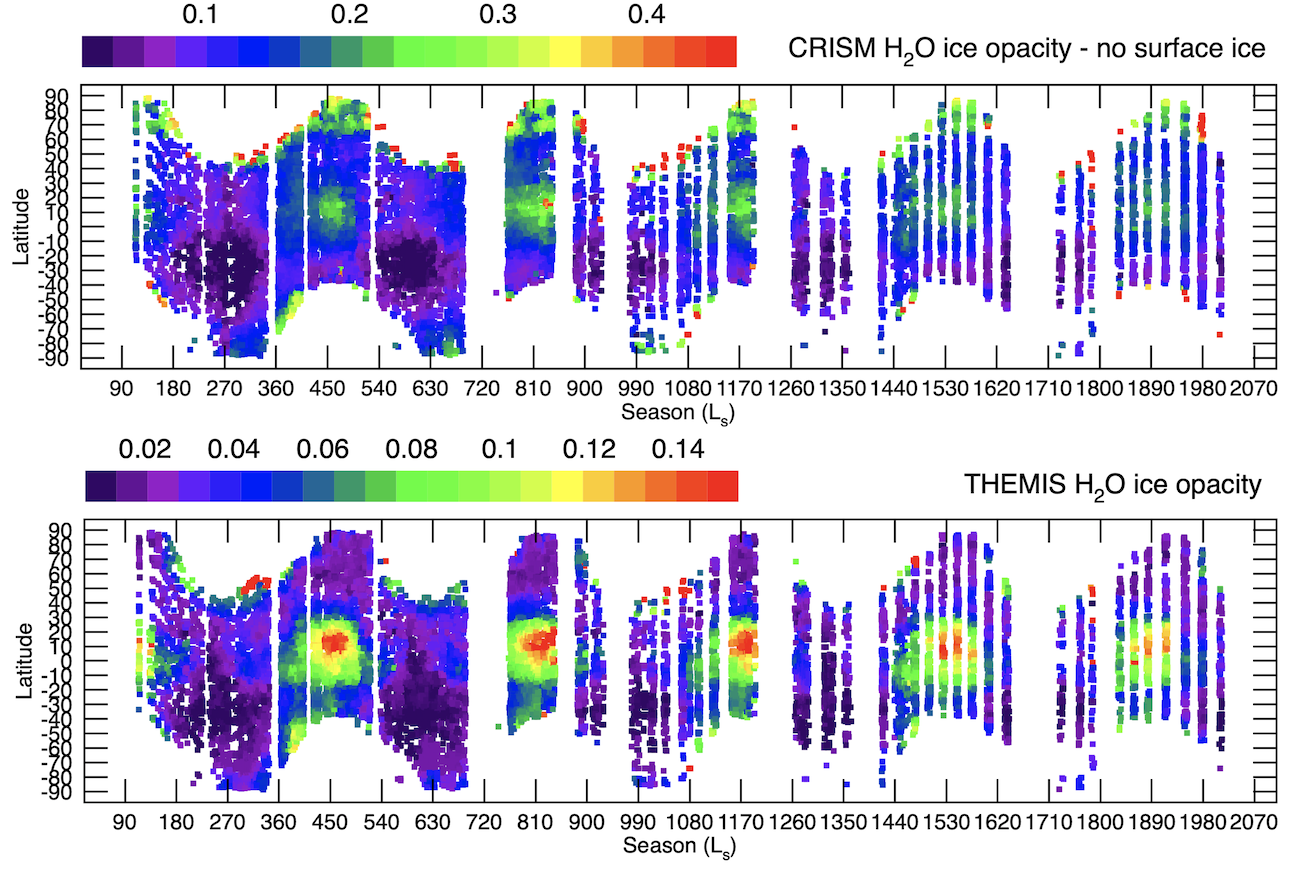Mars atmospheric water ice climatology as retrieved by MRO/CRISM: 5 years of observations
- 1NASA Goddard Space Flight Center, Greenbelt, MD, USA
- 2Center for Research and Exploration in Space Science & Technology (CRESST II), Department of Astronomy, University of Maryland, MD, USA
- 3Space Science Institute, Boulder, CO, USA
- 4Center for Space Sciences and Technology (CSST), University of Maryland Baltimore County (UMBC), MD, USA
- 5Laboratory for Atmospheric and Space Physics, Boulder, CO, USA
Background
Water vapor in the Martian atmosphere can condense into ice-crystals, forming water ice clouds. At one hand, this works as a cooling mechanism by reflecting incoming solar radiation back into space, and on the other hand as a warming mechanism by the absorption of outgoing longwave radiation from the surface of the planet.
Near-infrared observations taken by the Compact Reconnaissance Imaging Spectrometer (CRISM) aboard the Mars Reconnaissance Orbiter (MRO) provide important information about the atmospheric constituents of Mars, including water ice aerosols. The wealth of data collected in the time period between September 2006 (Mars Year MY28, Ls = 112°) and September 2016 (MY33, Ls = 86°) covers over 5+ Martian years. We here present water ice aerosol opacity maps to provide insights into its spatial, seasonal and interannual variability, and its implications on cloud formation.
Methodology
The retrieval algorithm used here is first described in Smith et al. (2009) and subsequently adapted and used to provide CRISM atmospheric water ice opacity retrievals. The first step in the retrieval process is to define the background continuum level in the CRISM spectra by fitting the Lambert albedo of the surface between two continuum channels at 2462 nm and 3797 nm away from major absorption bands, and then linearly interpolate the continuum levels between the two channels. A-priori water ice aerosol optical depths are taken from concurrent Mars Odyssey Thermal Emission Imaging System THEMIS observations (Smith et al., 2003). The retrieval process then applies a correlated-k approximation method for gas absorption (Lacis and Oinas, 1991) on the central observation where it calculates the gas absorption (mainly CO2 and water vapor) using tabulated values of opacities until convergence between the modeled and observed CRISM spectrum. We utilized the water ice feature (Fig. 1) by fitting the spectra in the 2900 – 3700 nm range at three channels at 2900 nm, 3497 nm and 3603 nm, from 30,000+ near-nadir targeted CRISM spectra to generate maps of the column integrated water ice opacity. The water ice is assumed to be well mixed above the water condensation level, and the ice clouds are assumed to be composed of 2-micron particles (e.g., Smith et al. 2009; 2018). Multiple scattering from water ice aerosols was treated using the discrete ordinates method described in Thomas & Stamnes (1999), as in Smith et al. (2018).
Results:
At the CRISM near-infrared wavelength regime, strong absorption features originating from the presence of H2O and CO2 surface ice from the north and south polar layered deposits heavily influence the retrievals of atmospheric water aerosol opacities, therefore we avoided retrievals over surface ice using a threshold on the presence of surface ice as defined in previous works (e.g., Khayat et al., 2019). The generated CRISM water ice climatology from CRISM is shown in Figure 2. The decrease in the frequency of observations beyond the second Mars year is due to the degradation of the cryocooler on CRISM, leading to a careful planning of the observations, and the vertical gaps are due to spacecraft anomalies and to the lack of data collection during solar conjunction. The aphelion cloud belt (ACB) is well observed around Ls = 90° for every Mars year at the equatorial latitudes, and lasting for at least a period of Ls = 100°. The ACB exhibits small interannual variability, with lower values of ice opacity at MY 29 (Ls ~ 450°) and higher values at MY 30 (Ls ~ 810°) and MY 31 (Ls ~ 1170°). A lack of water ice aerosols (τ3300nm < 0.1) is observed during northern autumn and winter of every Mars year in the southern hemisphere, and reaching latitudes in the north up to 50 °N at the beginning of northern winter. High opacities of water ice aerosols (τ3300nm > 0.4) are observed at high northern latitudes (> 50 °N) and last for the entirety of the northern winter, followed by values around (τ3300nm ~ 0.25) over the polar latitudes in the north at the beginning of northern summer and lasting for the whole season. A similar trend is observed in the THEMIS water ice climatology with the respect to the timing in the maxima and minima in the optical depths, but a noticeable difference is observed over the north polar latitudes around the beginning of northern summer where high water ice opacities are not observed in the THEMIS climatology. A detailed analysis to address this discrepancy is currently underway.
Acknowledgments:
The authors acknowledge financial support from the NASA Mars Reconnaissance Orbiter project and are grateful for the work done by the CRISM operations team. This work is supported by the NASA ROSES Planetary Data Archiving, Restoration, and tools, grant number 80NSSC21K0880.
References:
[1] Khayat, A. SJ., Smith, M. D., Guzewich, S. D., 2019. Icarus 321, 722-735.
[2] Lacis, A.A., Oinas, V., 1991. J. Geo- phys. Res., 96, 9027 – 9063.
[3] Smith, M. D., J. L. Bandfield, P. R. Christensen, and M. I. Richardson, 2003. J. Geophys. Res., 108(E11), 5115.
[4] Smith, M.D., Wolff, M.J., Clancy, R.T., Murchie, S.L., 2009. J. Geophysics. Res. 114, E00D03.
[5] Smith, M.D., Daerden, F., Neary, L., Khayat, A., 2018. Icarus301,117–131.
[6] Thomas, G.E., Stamnes, K., 1999. Cambridge Univ. Press, Cambridge.

Figure 1: Near-nadir CRISM spectrum from observation EPF0000B8A4 taken around the aphelion cloud belt around Ls = 90°. The highlighted areas in light red represents the atmospheric absorption band at 2000 nm belonging to CO2 and it is used to retrieved the surface pressure. A large water ice aerosol feature is detected in the 3000 – 3700 nm range and is highlighted in blue.

Figure 2: Upper panel: CRISM retrieved zonal water ice opacity (Tau) from near-infrared spectra around 3300 nm between MY28 and MY33 taken at ~ 15:00 local time. Lower panel: Concurrent THEMIS water ice opacity at 12120 nm (825 cm-1) interpolated at the location and season on Mars.
How to cite: Khayat, A., Smith, M., Wolff, M., Guzewich, S., Mason, E., and Atwood, S.: Mars atmospheric water ice climatology as retrieved by MRO/CRISM: 5 years of observations, Europlanet Science Congress 2022, Granada, Spain, 18–23 Sep 2022, EPSC2022-617, https://doi.org/10.5194/epsc2022-617, 2022.

